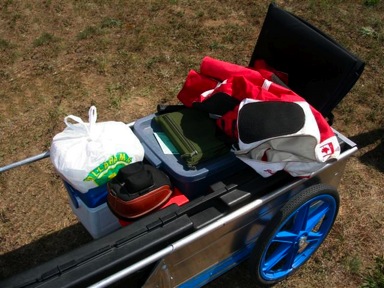
I have seen many published lists of what should technically be in the kit. You can find one listing on the ORA website, www.ontariorifleassociation.org/ under “More Info/Shooting Kit.” After years of being in the game, I’ve found my kit is still in a constant state of flux. I believe the weather predicts to a degree what kit arrives with me at the range for practice or competition. Even if you guessed it right you still have to decide exactly what’s going out on the playing field! Like, how many times have you been caught with your rain gear or umbrella left stored in your vehicle? This discovery usually happens when you're at the 300 yard markers and it's a long way back to your your vehicle and guess what You're really is up to the line in 5 minutes. I might suggest that you consider which items you’ll settle on after a number of trips to the range. The trips allow you to see what other people are using before you rush out and buy a whole whack of stuff. You can not only see the gear but you can also ask the shooters using it how well it works for them.
You definitely need the following, a rifle c/w bolt and ammunition that fits the chamber and don’t laugh. You leave your bolt at home or you grab the wrong ammunition container or one that’s poorly marked before leaving home, and I’ll guarantee you’ll see the day go by with your rifle secured in its case. If you reload your own ammunition; by the way who’s not reloading these days, you are at higher risk arriving with the wrong stuff. It could be as simply as bullets seated too far in, too far out or the cases weren’t sized correctly to fit the chamber. Then there’s reloads that are too hot or loads that don’t have enough velocity but this is really subject matter for another article. Just make sure you’ve got enough rounds loaded for what you are doing and especially for a competition and that you know they will all chamber properly. We generally spend the whole day at the range, a good 6-8 hours so the following should be considered.
Minimum Items:Liquids - Hands down the best is bottled water! It will quench a thirst. Drinks like Gatorade comes to mind, but I tried that stuff and you know I’m still thirsty shortly afterwards. Carbonated drinks just don’t work. They contain high amounts of caffeine and especially sugar if you’re drinking the regular carbonated drinks. yet I after many years I still show up with them and I’m not proud of it. Sometimes it’s very hard to teach an old dog new tricks. Whatever you bring, bring enough to get you through the day. One bottle or even two bottles is definitely not enough. Take 3 for sure, heck take a bunch because two things will happen. First you be on the range with just a couple and someone will come up to you and end up with that second bottle because they forgot to bring even one and your such a nice person that it’s going to haunt you through the rest of the day that you couldn’t bail a fellow shooters from out of a predicament. Second what’s left can be consumed on the trip home. I’m always thirsty homeward bound.
Lunch - Some type of lunch. You need to eat something. You can’t shoot a whole day on an empty stomach. Here again I’m a hard dog to train and there’s times where I’ll go the full day without eating anything. This is pure nonsense and I know it. My excuse is that I feel like throwing up if I’ve got stuff in my stomach. It reminds me of my high school football days. We had this one guy who, whatever he ate just threw it up. You could usually hear him hurling in the locker room just before going on the field. He got that tensed up. At least some type of snack. There are a number of good energy bars out there. Chocolate bars forget it, too high in caffeine and sugar. Fresh fruit is a very good choice in my opinion. That’s what I have been trying lately and it does seem to be working. You might want to consider a small cooler to store your lunch, your drinks or both. I did say a “small” one! You’re carrying around on the range no one else it going to do it for you.
Shooting Mat - Something moisture proof to lie on if it is damp. You’ll be on a grassy berm in an open field. Very early in the morning there is likely to be a lot of dew on the ground. About the best bang for the buck is a proper shooting mat. A good pair of boots doesn’t hurt either, but you wear that. One the best mats I’ve seen is made by Paul Bawden-Marksmans Accessories. Paul can be reached at rpbawden@aol.com. A tri-fold or roll up mat is good. Either will be adequate on the range. You can see some of his products here www.centerthegroup.com/contact_info.htm. Paul makes all kinds of shooting gear. He has some great soft rifle cases which actually fit long rifles. You know, those 30-32” barrels so check his stuff out! Some guys like me use cheap plastic gun cases for the short hauls.
Rain Gear - Is a must for any day where it looks like it might rain. A suit meaning a pant/jacket combination is better than just a jacket or top. The pants can also be worn as a windbreak during the spring and fall when it much cooler. Make sure they are seriously waterproofed, especially at the seams and try to find the breathable kind where moisture doesn’t’ build up inside the suit. They’re more expensive but worth it in the long run. The better suits also will not let the rain bleed through when you’re lying down in position. A light steady drizzle will get you just as wet as a ten minute downpour. Wet is wet any time it rains. It’s also a good idea to consider an extra set of clothing and keep it stored in your vehicle. You don’t have to bring the extra set on the field. A drive home in seriously wet clothing is an invitation to picking up a cold. Another consideration that many people don’t think about before coming to the range is how to protect your gear from the rain. There are many types of small square or rectangular tarps that can be purchased cheaply used to put over your gear to help keep the rain off it. You should consider bringing something like this with you and have a method to attach or secure it.
Hat and gloves - There are a number of caps, hats and gloves that are in general use. Gloves are used mostly by TR type shooters. Hat’s block the sun from getting into your scope.
Footwear is important - Running shoes are fine for those days where the ground is completely dry. But I find a boot is better especially the waterproof type. It protects you earlier in the morning on dew soaked grounds and it gives better ankle support on uneven ground. Hiking boots are another choice.
Spotting Scopes - Are used to check scoring. If you’re shooting F-Class odds are you’re scope will be powerful enough to see the values right out to 1000 yards. But mirage can be an issue. If there’s heavy mirage it’s just as difficult to see the target through a spotting scope.
Some type of clipboard or binder - You can store your plots, come-ups or anything that you won’t remember as the day progresses on a clipboard or in a binder. Pencils may be better than pens on a wet day or those Sharpie things which come in many colours.
Additional Items:If you take a lot of stuff on the field you’ll need some type of a wheeled device to move it about. I use a Fold-It Cart with two large bicycle type wheels that don’t get stuck ever. Heck if it’s good enough for Art Grundy, it’s good enough form me! Some folks have made some interesting contraptions and you’ll see them being pushed around the range. One style can be generated from an old golf cart set of wheels & frame, right Roy? If you use one for golfing you’re good to go. You’re going to give that game up in favour of this sport! The cart shown here can be found by doing a search on the web for Fold-It Cart by Tipke Manufacturing. You’ll get a number of hits. From here you can wander around until you find one at the price you’re willing to pay or until you’re called to the dinner table. They aren’t cheap but they’ll last a life time and naturally these things can be used around the house for what they were designed for in the first place, gardening, brilliant! Some additional notes on the carts. My buddy Norm bought one with a slightly higher edge on the sides and back. Norm is a very bright light. This is a nice feature because with mine I pile stuff high and it’s falling off as I move to the next yardage. I always have to keep an eye on the trail of gear I might be leaving behind. So you might want to consider this aspect. Of course if you get it bigger there’s going to be a tendency to stack more things in it. Some carts are shorter or the distance between the pull out handle and the back of the cart is too short for some of the longer rifle cases. Just think about this when getting one. the rifle case need to fit between the inside back of the cart and inside the handle otherwise it's really awkward! If you use a soft rifle case the point might be mute. Tipke have a 1300 and 2100 model. Get them from a garden supply place where they have them for a lower price... search the internet first so you have an idea.
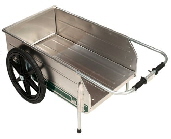
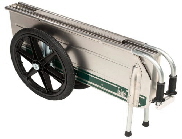
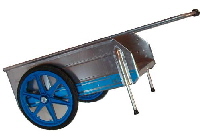
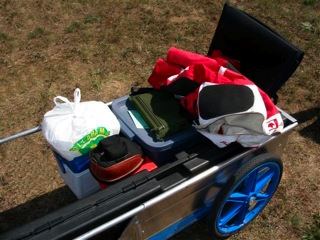
Rifle Cases - Some people leave their cases back in their vehicles. I don’t, when the rifle is not in use I want it back in the case. The case protects it from sand, dirt, rain and from being trod on by anyone walking past it, well almost! Also some folks shoot two rifles. One for short range and one for long range which means they are going to be bringing both of them on the field or making a trip back to their vehicle to do an exchange. Soft cases also work well for them as some of my buds on the net reminded me. I might add that you might possible have to consider the case thing carefully. Most of don’t have to do that. You can probably go with a reasonably cheap case if you shoot a lot of local matches and it would be as simply as deciding on a cheap hard or soft case. If you shoot national or international events or you are eventually considering doing such then you have to consider some type of gorilla strength case. If you’re travelling by a land vehicle to matches and you’ll be the only one or just about the only one handling the rifle cases you don’t have to get to elaborate. But if you fly anywhere either across your country or to an international destination then you need to think about how secure can the rifles be locked up and can they take some pretty good abuse. If you buy a cheap one then you may have to buy another one when you fly. The point could be mute if you are able to borrow one from a fellow competitor. It wouldn’t cost you anything to ask one of your shooting buddies but the odds are they’re also going to the match, right? They’re not going to let you have all this fun on your own.
Small folding chair c/w with a back and umbrella - I take both and make use of either on any given day. It gets you off the ground away from the insects and man-eating grasshoppers. It’s amazing the number of things that can bite you if you’re sitting directly on the ground. The umbrella protects you from the sun and is useful when it rains. Mine clamps to my chair so it’s not suppose to get blown away but if the wind does grab it your in for a few bent metal ribs and when you try to straighten them they break. Make sure that whatever you bring onto the range is secured behind the line. On an open range such as the ones we shoot on the wind can blow things around pretty good. You do not want any of you’re gear ending up in front of the firing line! I tried a folding stool once... it’s useless for comfort but it does pack small!
Rests - Rest are something a lot of F-Class shooters use. I use one and it’s big and heavy. It’s a Farley rest with a joystick. The stick handles both elevation and windage changes together. It’s an interesting rest. A lot of folks use the Sinclair rests (or something similar) and they work for them. any good quality rest will work. I’ve modified mine with f-class feet. I also use a rear bag and it fits into a spot on my cart or goes into the blue tub.
Cleaning Rods and Items - Definitely a cleaning rod stored in a case is a good idea. If you ever have a round that leaves a bullet stuck in the bore. You might be able to get it out with the use of a single piece cleaning rod. Stay away from 3 piece rods. These things are worse than useless! Naturally, a rubber mallet would also come in handy which can be used to lightly tap the handle end of the rod to help dislodge the stuck bullet. Guess that depends on stuck it is.
A small tool box could be used to store some of the cleaning stuff like bore cleaners and patches, bronze jags, a set of Allen keys or small screw drivers to fit all the screws on your rifle including those found on your rings and scope. Pliers might be handy, a roll of masking tape and duct or electrical tape, some cleaning cloths and any other tool items you generally find yourself using over a period of time. It’s best to have them all together in one spot. There are all kinds of neat plastic containers in addition to the regular small tool boxes. We’re talking a field kit here not some kind of full-blown benchrest outfit… though some would frown on including any of the cleaning items I’ve mentioned. Some guys use moly and their time between cleans is long and distinguished. If your barrel stops shooting though... well let’s not go there!
No two kits will be identical. Everyone has an opinion on what they want with them. I just listed some of the stuff I’ve had in my vehicle or on the range with me. I doubt you’d ever find me with just a rifle and ammunition for it. I don’t find it that simple.
It’s what you bring to the line that really matters and I’ll talk about it in another article.